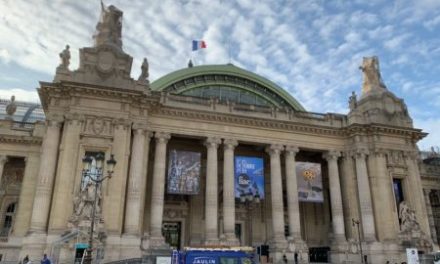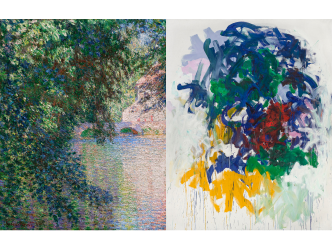When the impressionist painter Auguste Renoir wrote these words in 1908 to his dealer Paul Durand-Ruel, he himself was painting flabby, listless creatures in verdant landscapes that expressed only a shadow of his former genius.
How can we know who in contemporary art will be of value in 10, 20 or 30 years’ time?
In France, there is a place little known to the wider public that was proving its worth from as early as the end of the 1970s.
And it wasn’t even in Paris. Around this time two young graduates, Xavier Douroux and Franck Gautherot, were championing and exhibiting artists, inspired by a staggeringly international vision, in the heart of the art centre they’d founded, Le Consortium, in Dijon.
They have a long list of accomplishments, including putting on shows for Christian Boltanski in 1978 and Cindy Sherman in 1980, then very early in the careers of other artists who would go on to become stars of the global art scene, like Maurizio Cattelan (1997), Pierre Huyghe (1997), and Ugo Rondinone (1997).
The New York Times recently described the place, which has since been enriched by other curators, as: “The under-the-radar French museum that quietly predicts art’s next big thing” (cf this article from the NY Times)
But just under a year ago, Xavier Douroux passed away. His death was followed by a period of reassessment and Le Consortium now wants to adopt a new approach.
It has therefore called upon some of its artists to donate works to help bring about a revival of the place, whose architecture was designed by Shigeru Ban.
The result is an auction on 7 June at Christie’s in Paris, with 22 lots estimated at 900,000 euros in total.
Franck Gautherot explains this approach:
The preface to the catalogue was written, on his own initiative, by the owner of Christie’s and famous art collector François Pinault. In 1983
Le Consortium displayed the work of the famous American artist Richard Prince (born in 1949) in 1983. He was already recycling images depicting stereotypes of the time.
He is best known for his large scale photographs of a cowboy inspired by an ads from a cigarette brand, but the sale features a set of 10 prints depicting a man’s wrist with a watch, which was exhibited at Le Consortium at the time. (Estimate: 20,000 euros).
Le Consortium also witnessed the evolution of artists’ efforts to challenge conventional painting.
Over the past few years some of them have been developing a form of painting using highly simplified shapes inherited from Pop Art.
This is the case of the Californian artist Brian Calvin (born in 1969) who is sometimes presented as an heir to David Hockney. He exhibited at Le Consortium in 2015 with a noteworthy series of close-up portraits of women that are smooth, colourful and at the same time imbued with a casual glamour, like how young people today would like to imagine themselves on their phones.
One painting of this type made in 2017, “New Bloom”, is to be presented on 7 June with an estimate of 20,000 euros. The artist’s record price at auction amounts to 37,400 euros.
In 2002 Le Consortium exhibited the work of Christopher Wool (born in 1955), an American painter who has become one of the superstars of the art market. On 12 May 2015 in New York one of his canvases painted with the letters RIOT from 1990 was sold at auction for the record price of 26.8 million euros. His practice consists of challenging conventional painting through the use of silkscreen, repeated motifs and recycling his own gestures. The painting on paper due to be presented on 7 June was made in 2016 by repainting over a silkscreen print. It’s estimated at 100,000 euros.
The American artist Wade Guyton (born in 1972) could be considered to be an heir to Wool’s approach who also draws on the techniques of Andy Warhol.
He composes his artworks according to principles of contemporary reproducibility, using digital printing on canvas. He exhibited at Le Consortium in 2016 (cf the report on the subject) after his work – to his great displeasure – was swept up in a whirlwind of market speculation.
[videohere v=”180720413″]
In 2014 one of his paintings sold at auction for 4.3 million euros. Since then, demand for his work has fallen and so have his prices. The work featured in the sale for Le Consortium, dating from 2018, is estimated at 150,000 euros.
The same estimate that has been ascribed to an abstract painting by another American artist, Joe Bradley (born in 1975), who exhibited at Dijon in 2014.
[videohere v=”106385096″]
In his work, conventional painting is challenged by the fact that he borrows simultaneously from a wide range of styles. He is collected by high-profile art lovers like Peter Brant, who’s currently dedicating an exhibition to him at his foundation in Connecticut. The fact that he is on the roster of the multinational Gagosian Gallery has also helped propel his value upwards.
It’s fascinating to observe that all these artists who’ve shown generosity had not previously hesitated to take the step from New York or Los Angeles to exhibit in Dijon, a town that hasn’t been a capital since the Middle Ages.
Support independent news on art.
Your contribution : Make a monthly commitment to support JB Reports or a one off contribution as and when you feel like it. Choose the option that suits you best.
Need to cancel a recurring donation? Please go here.
The donation is considered to be a subscription for a fee set by the donor and for a duration also set by the donor.










